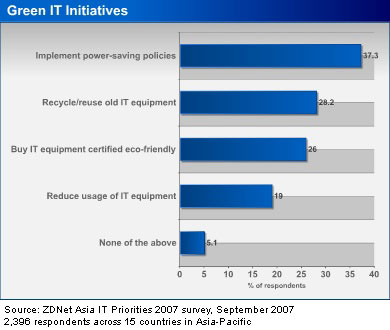Green issues are slowly making their way into corporate Asia's business agenda, but more can--and should--be done.
At least one-third of the 2,396 respondents in ZDNet Asia's IT Priorities 2007/2008 survey indicated that their organizations were doing their bit for the environment, although--with the exception of some mentions--green IT did not make it to the list of top IT priorities.

"Environmental issues are starting to be felt," said Graeme Philipson, an independent industry analyst commissioned to help with the ZDNet Asia survey analysis. "But note that in the unprompted questions about IT priorities, environmental issues--while attracting some mentions--were relatively unimportant."
When asked what green IT initiatives had been adopted, 37 percent said they were implementing power-saving policies, such as turning off computers outside of working hours. Other popular eco-friendly activities were recycling or reusing IT equipment (28 percent); purchasing IT equipment that were certified eco-friendly (26 percent); and reducing the usage of IT equipment (19 percent). Five percent said they were not doing anything that were specifically eco-friendly.
Commenting on the survey findings, Simon Mingay, an analyst with Gartner, said: "These statistics certainly represent a great start, and suggests that many of the environmental issues are not new to your readers. But like every other [global issue], there remains a lot of room for improvement and cost savings.
"A start is a start--so whether it is small or large, it's a step in the right direction, and can be followed up with many other eco-efficiency and cost-effective measures," he added.
Tony Parkinson, vice president and general manager for Industry Standard Servers, Hewlett-Packard (HP) Asia-Pacific and Japan, said the survey findings were not a surprise. "We hear HP customers are looking to save money through more energy-efficient products, or to find easier ways to recycle their HP technology," Parkinson said.
However, one analyst highlighted some potentially conflicting statistics. Rakesh Kumar, vice president of Gartner, said: "These figures seem higher than I would have expected. For example, 19 percent said they were reducing the amount of IT equipment--[that's] strange when there is volume growth across all classes of hardware equipment."
On the 5 percent who were not embracing green practices, Mingay said the percentage was "surprisingly low".
"They need to understand the potential cost savings and how environmental issues might be important to their business. Failing those two things, or regulation, little will get them to change," he said.
Who's buying green tech?
The three broad drivers of green adoption are cost savings, compliance with regulations, and corporate social responsibility to build a positive corporate brand or image.
Philip Carter, IDC's Asia-Pacific green IT lead, said cost savings and compliance are the two biggest green IT investment drivers in Asia, excluding Japan.
"At least for now, and in the near future," Carter said. "This corroborates the findings of ZDNet Asia's survey, since activities like power saving, recycling or reuse, usually derive the most cost benefits for organizations that implement targeted programs in these areas."
Indeed, Asian businesses should see the big picture of benefits they can enjoy from adopting eco-friendly initiatives.
Lionel Lim, Sun Microsystems' president for Asia South and Greater China, said: "'Eco' stands for both ecology and economics. Running eco-friendly servers offer compute power at reduced energy for both the machines, and the air-conditioning, to cool data centers.
"This in turn leads to less pollution and global warming, while ensuring that less money goes to energy bills used to cool the data center," Lim explained. "Therefore, eco-friendliness benefits everyone as it saves the earth and saves money for businesses."
However, efforts by hardware vendors to market energy-efficient products may be falling on deaf ears, according to IDC.
"For the most part, IT managers are currently not using eco-friendliness as a criterion for their purchasing decisions. And when they do, it is only where cost savings are potentially there, or when they have to due to regulations," Carter said, adding however that attitudes could change in the future.
On what it will take to change their minds, Gartner's Kumar said: "A big financial kick in the butt, or government directives."
